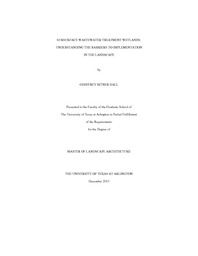| dc.description.abstract | The purpose of this research is to address the barriers to implementation of, the role of landscape architects in, and the potential for acceptance of constructed subsurface flow wastewater treatment wetlands. Landscape architects, engineers, and scientists are key players in the implementation of subsurface flow wastewater treatment wetlands in the landscape. Through qualitative inquiry, this research uncovers the opinions of landscape architects, engineers, and scientists regarding the potential barriers to building subsurface flow wastewater treatment wetlands and ways to overcome these barriers.Subsurface flow wastewater treatment wetlands are a decentralized form of wastewater treatment, treating wastewater onsite using little to no power (USEPA, 2000b). While centralized wastewater treatment pumps wastewater to a distant plant where it is treated (USEPA, 2004), decentralized systems treat wastewater onsite (CGBC, 2011a). Decentralized systems reduce pressure on overloaded wastewater treatment plants and create green infrastructure (Libralato et. al, 2011). Both methods return wastewater to a freshwater source. This research utilized interviews with landscape architects, engineers, and scientists about their experience with the implementation of subsurface flow wastewater treatment wetlands. The interviews uncovered the opinions on the limitations of using this technique as a part of onsite wastewater treatment. Emphasis was placed on the domain of landscape architecture and interactions with the public when subsurface flow wastewater treatment wetlands are included in designs. Interviews uncovered information regarding the need for landscape architects, engineers, and scientists to work together as a team throughout the design phase and during construction. Also, the effects of education on professionals, the public, and government in relationship to acceptance of SSF are summarized. Proposals for the reuse of wastewater for irrigation, cooling, and water features are discussed as well. Findings indicate that although many barriers to implementation exist, the most prevalent is the lack of education among the public, professionals, and government regulators regarding the availability and performance of subsurface flow wastewater treatment wetlands. | en_US |

